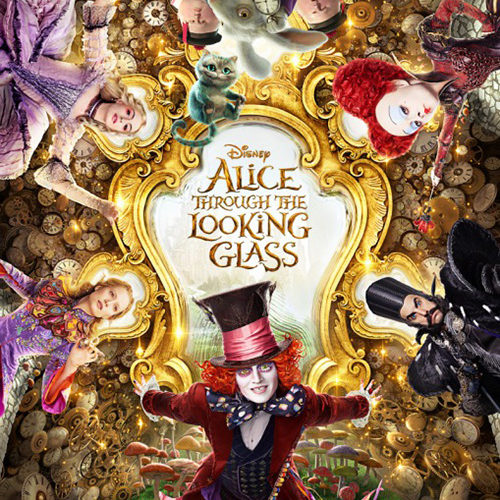The central plot mechanism of Alice Through the Looking Glass is an actual mechanism, a doodad of whirling steampunk metal and glowy CGI called the Chronosphere. Alice (Mia Wasikowska) drops the little ball and it suddenly grows so that she can step inside and use it to travel through time. “Oh, so it shrinks and enlarges as is convenient. Like a video game tool,” I thought. I was primed for this by the fact that the Chronosphere is housed in a clockwork castle which looks ripped off wholesale from the Tick Tock Clock course from Super Mario 64. Alice even has to hotfoot it over a winding shaft, the same as Mario must do in that level. It’s cliche to compare weightless, CG-heavy cinematic action to watching someone play a video game, but I don’t think that’s fair. I mean, at least with a video game speedrun on YouTube, you get to bear witness to some actual skill.
There’s some confusion over whether the mushroom which Alice eats to change size in Alice in Wonderland inspired Shigeru Miyamoto to come up with the similarly size-changing mushroom power-ups in the original Super Mario Brothers. Regardless, pretty much any given classic video game platformer hews truer to the spirit of Lewis Carroll’s Alice books than any of the myriad film and television adaptations, what with their assemblages of nonsense animal characters and blissfully superfluous plots whose contrivances bear no killjoy strain of logic. Through the Looking Glass, a sequel to Tim Burton’s 2010 Alice in Wonderland movie, continues its predecessor’s determination to shackle Wonderland’s whimsy to backstories and “realistic” (read those quotation marks as sarcastically as you can) psychology. Look no further than this if you want to figure out why most kids would much rather play Minecraft than go to a theater.

To whit, a tart-stealing incident which is the focal point of a sunnily absurd trial in the Alice in Wonderland book is here “reimagined” as the origin of all the enmity between the White Queen, Mirana of Marmoreal (Anne Hathaway), and the Red Queen, Iracebeth of Crims (Helena Bonham Carter), and is presented with the attendant deathly seriousness. There is much solemn posturing and dramatic shouting, and Hathaway even does a classic Dark Thousand-Yard Stare Off to the Side over its memory. Over tarts. It makes the kiddie-pandering humor around the personification of Time (Sacha Baron Cohen) pratfalling about much, much stranger.
Whereas 2010’s Alice in Wonderland slotted Carroll’s characters into the roles of a generic hero’s journey, Through the Looking Glass has more pared-down concerns. The budget is bigger this time around, but most of it is spent on ultra-elaborate animated landscapes, such as the aforementioned clock castle, instead of crowds, so Wonderland feels oddly depopulated. Though it involves time travel and eventually threatens the end of all existence, the story is mostly about Alice trying to help the Mad Hatter (Johnny Depp) reunite with his long-lost family via time travel shenanigans. Linda Woolverton’s script makes a sincere attempt to say something about grief and regret, and at times almost seems about to make an impression. But leaning on an assumption (made without evidence) of built-in love for any of these characters only makes the movie fall over. Who cares about Alice as a Yass Queen feminist hero if Wasikowska just sort of greets everything from annoying robots to the cataclysmic end of existence with vague concern?

Then again, we seem meant not to merely take these characters as these films present them, but to watch with their full cultural weight on our minds. Had the first Alice film come out a few years later, in the midst of Disney’s weird trend of remaking all of its animated hits as live-action features, there surely would have been directives from the higher-ups that everything be designed to be reminiscent of the look of the studio’s 1951 cartoon. Although that might have been preferable to the half-assed quirks each actor brings to their characters. Hathaway can’t even be bothered to flutter her arms with vigor, and Depp … you know what Depp does at this point. It boggles the mind that every major actor from the first film returned for this one except Crispin Glover. How did he pull that off? I mean, not even Alan Rickman escaped, and he died.
Whether because he’s new to the blockbuster game or because all those big special effects canvasses must be fully appreciated, director James Bobin at least keeps the busy visuals semi-comprehensible with a steady camera. Of course, busyness is not beauty, no matter how elaborately the Cheshire Cat’s fur is rendered, and the shots are framed with little grace. There are moments in which the movie nearly becomes distinctive. Travel through time is visualized as sailing a roiling ocean. Entropy rapidly spreads across the universe as virulent rust. And then we’re back with Depp lisping and I want to break my 3D glasses.
Oddly, I don’t feel the hate for Alice Through the Looking Glass in the same way I remember feeling for the first film. Tim Burton’s apathetic Hot Topic affectation has at least been replaced by an honest stab at a story with resonance. It’s not wretched; just boring. A faintly damned improvement, but an improvement nonetheless.
Alice Through the Looking Glass opens nationwide on May 27.

